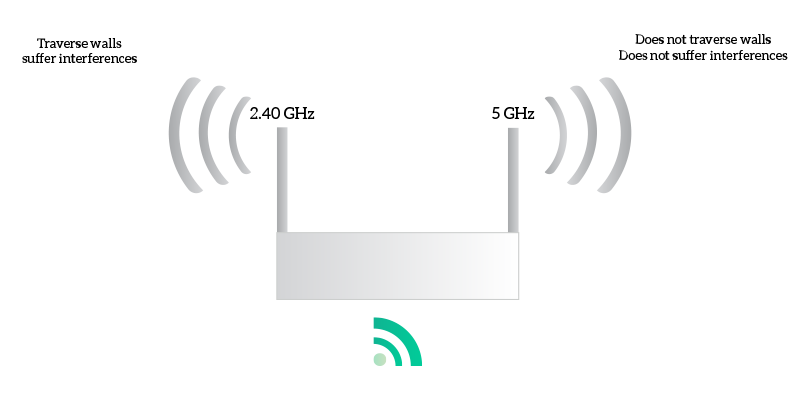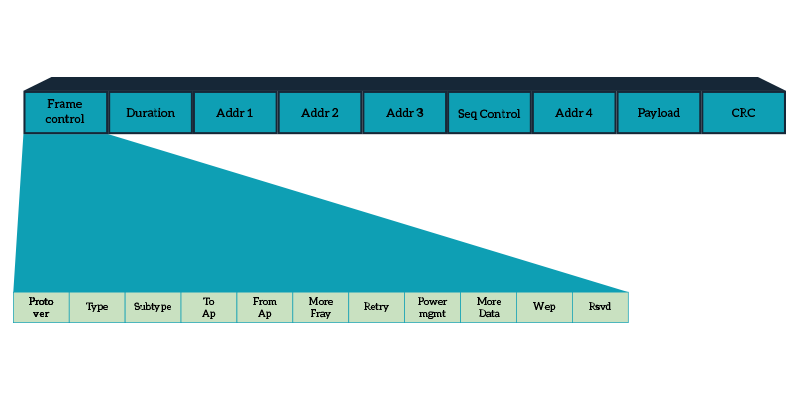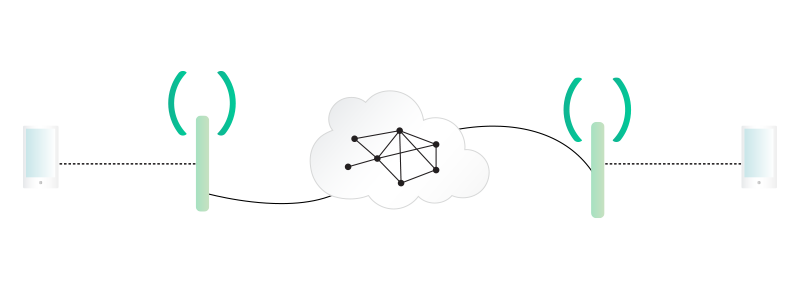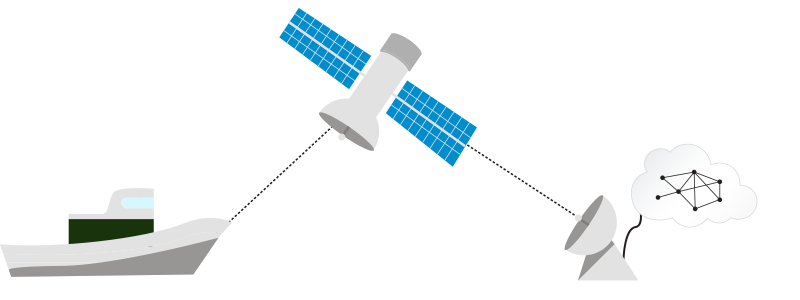Think about your smartphone, or about your laptop surfing on the web while you are at the airport. Think about your automated-home where you can turn on the heating remotely. Probably you already know that: none of these things would be possible if we weren’t able to send information over the air. Fortunately, we can, so no wire is needed: here’s the wireless communication. However, saying wireless is not enough – many different technologies exist to transport data in the air, and this is the article where we talk about them.
Wireless: Information over thin air
We already know back from the copper media article that sending information can be challenging even if we send it in a dedicated cable enclosed by a PVC jacket, so it can be only harder to send the information over the air. The hard part is not sending the information all by itself but ensuring that it can reach the destination in such a way that the receiver can still read it. In the air, as in the void, the electromagnetic interferences are a serious threat to our signal, because they share the air with it. In a cable, the signal was somehow protected by the shielding layers, but in the air, it is not. Another great obstacle is anything of a certain thickness in the path the signal is traveling. Water, lead, but even normal walls and other solid obstacles can completely block some signals. Fortunately, there’s always a solution.
The first thing to clarify is how is it possible that we send signals in the air in the first place. This is possible because any electromagnetic oscillation or wave at a certain frequency and power starts to propagate in the void, or in the air. This is a physics principle and we won’t go deeper on that, but we can take it for granted. Using some tricks such as antennas and amplifiers we can leverage on this principle and enhance the transmission, for instance reaching longer distances. Some specific frequencies are used to transmit signals over the air, depending on the type of transmission (local to a building or to an entire region), but as a rule, remember that:
The higher the frequency, the faster the transmission, and the lower the tolerance to solid obstacles.
For example, light is an electromagnetic signal having frequencies of several THz and can be blocked by a paper sheet. Instead, the human voice has very lower frequencies (billions of times lower) and can even traverse a wall. Talking about the human voice, if several people start to talk all at the same time, they will overlap and it will be very hard to understand one or the other. The same goes for data transfer, if more devices are talking all at the same frequency they will overlap and the signal of one will merge with one of the other, disrupting both signals. To overcome that, at the Data Link layer some techniques are implemented to detect collisions and define when each device can talk since a single one can talk at a given time. Now you might be left wondering how this is possible since you are able to do everything you want whenever you want using your wireless connection while another person using the same connection do the same. And this is possible because the “turn” of each device changes a lot of times within a second, giving a sense of continuity.
Another important thing that this layer has to care about is interferences. Here we cannot just detect them, we have also to prevent the damage they make. Therefore, in wireless transmission, there is always a heavy use of constellations with error corrections. With a constellation, only some combinations of bits can be accepted from the receiver, and if it detects an invalid bit it will also know which was the original valid bit (more information in the article dedicated to binary math). On top of that, there is an extra check performed at the data link layer just to be sure that the constellation mechanism is working. Just to give you an overview of this mechanism – that we will explain when we will talk about the data link layer – the sender creates a summary of the message it is going to send, then send the message with the summary. The receiver takes the message and re-creates the summary if the summary recreated by the receiver and the one sent by the sender are the same, then the message was not disrupted.
Now that you know the principles behind wireless transmission is time to talk about the several types of wireless transmission we use today. Each of them will be presented in more detail later in the article, but for now let’s just have an overview.

The first and most common wireless technology we are used to is Wi-Fi. It is a high-speed wireless connection used to connect devices within a small area, such as a building, a park, or several buildings. Another common wireless technology is Bluetooth, specifically for connecting devices in small ranges (such as 1-10 meters). It is relatively slow, cheap, and used to connect “extensions” of devices, such as connecting a smartphone to a headset or to your car. The other two technologies cover bigger areas: satellite connection gives low-speed and high-cost internet connection anywhere in the world (including the North Pole!) where no other connection can arrive. Mobile Internet instead, it is a lot like Wi-Fi but covers areas of several squared meters. All these connections, except Bluetooth, do the same thing: allow devices to connect without a wire to the wired network. In other words, the wired network reaches a specific device that then propagates the signal over the air. Now, let’s start with the first one: the Wi-Fi.
Wi-Fi
Wi-Fi, or WiFi, is the predominant technology in WLAN (Wireless Local Area Network). It is the technology used to connect end devices (smartphones, tablets, and computers mainly) inside a local context. That context can be a house, an office, an entire building or a campus composed of several buildings. Wi-Fi is also getting common as a free-internet solution that is provided in the streets of a town. In the simplest deployment, there is a single device that takes the Internet from the wired network and propagate it over the air, just like in a home network. In more sophisticated environments, there are several devices pushing the signal into the air, in order to increase the coverage. The device that bridges the wired network over the air is called Access Point (AP), because it is the device that wireless devices uses to connect to the internet, it is the Access Point. When working with multiple APs, it is mandatory to coordinate their operation in such a way that they do not overlap with one another. It is also possible that in an apartment building each apartment has its own AP, but each AP is pushing in the air a different network. Even if networks are different, APs that work on the same frequency will overlap, reducing the quality of the signal, thus slowing the connection. In apartment buildings, this could be a very common threat.
Wi-Fi works with signals at two different frequencies: you can choose to have your network pushed in the air at the frequency of 2.4GHz or at the frequency of 5GHz. Both these frequencies have several channels each, and you can think of a channel like a sub-frequency. In order for two APs to overlap, they will have to work on the same frequency and channel. Some APs are also able to detect the least congested channel and use it for their network. What is the difference between 2.4GHz channels and 5GHz channels? As we said before, 2.4GHz can traverse easily, while 5GHz cannot do that. However, 2.4GHz is subject to a lot of interferences (microwave ovens and electric appliances), while 5GHz is not. The best practice, today, is to use the 5GHz frequency. This way, you are going to need more APs to cover the same area, but you won’t suffer from interference. More than that, you can create a network that remains inside the walls of your home, building, or office, saving you from a lot of security risks. Vendors start to publicly say that the market is going in this direction: at the beginning of 2016, Cisco and Apple released a document saying that 2.4GHz Wi-Fi is to be considered obsolete.

Not all Wi-Fi technologies are the same: just like anything else in the field, Wi-Fi has been evolving over the years and several standards exist. All of these standards are sub-standards of the IEEE 802.11 standard which defines the Wi-Fi itself (you can find a lot about that on the IEEE website). Each of these sub-standards defines the operating frequency and transfer speed.
| Standard | Release Year | Frequency | Speed (Up to) | Indoor Coverage (m) | Outdoor Coverage (m) |
|---|---|---|---|---|---|
| 802.11 | 1997 | 2.4GHz | 2Mbps | 20 | 100 |
| 802.11a | 1999 | 5GHz, 3.7Ghz | 54Mbps | 35 | 120 |
| 802.11b | 1999 | 2.4GHz | 11Mbps | 35 | 140 |
| 802.11g | 2003 | 2.4GHz | 54Mbps | 38 | 140 |
| 802.11n | 2009 | 2.4GHz | 135Mbps | 70 | 250 |
| 802.11ac | 2013 | 5GHz | 780Mbps | 35 | – |
| 802.11ad | 2012 | 60GHz | 6.75Gbps | 60 | 100 |
On top of that, 802.11ah, aj, ax, and ay are being developed, with 802.11ay standard that should reach a transfer speed of 20-40 Gbps for a range of 300-500 meters coverage (official project status from IEEE). However, note that not all devices support all of these standards, some do not even support either 2.4GHz or 5GHz. Access Points able to push a network on both frequencies are called dual-band. For end devices, such as smartphones and computers, the compatibility with wireless standards is indicated with a slash notation (for example, a/b/g/n indicates that the device supports 802.11a, 802.11b, 802.11g, and 802.11n standards).
Now, it’s time for a fast immersion into the history of wireless. 802.11 is a relatively new standard, and it comes from the ALOHAnet, a network used to interconnect the Hawaiian islands that were an early forerunner of both 802.3 (Ethernet) and 802.11 (Wi-Fi). Now, the Wi-Fi development is managed by IEEE and The Wi-Fi Alliance. For all the issues you can encounter in a wireless transmission that we already discussed, it is easy to say that developing a way to transfer data reliably over the air is not easy at all. More than that, professional Access Points are able to push multiple networks over the air (each network is identified by a name, technically known as SSID), adding even more complexity. Just to prove that below we have the 802.11 frame. We won’t explain any of these fields, it’s not the time just yet, but just stare at the complexity.

As you can see, there’s a lot going on. All of that is sent every time you send a message, and since the message is divided into several packets (pieces of information), this has to be sent for every packet. For example, if you are trying to download a new wallpaper in Full HD that occupies about 2MB, you are going to need about 13,300 packets of 1200 bytes each (for example), so you are going to send and receive these stuff 13,300 times!
Mobile (3G and 4G)
Mobile Internet connections work a lot like Wi-Fi, but they cover a much greater area. Basically, there is an antenna that bridges mobile devices onto the physical wired network. Unlike Wi-Fi, which is provided by the owner of the LAN, Mobile Internet is propagated in the air directly by the Internet Provider, so you will have direct access to the Internet (that’s why we call it “Mobile Internet”).

Compared to Wi-Fi, the signal travels for further distances and can traverse ticker objects, but the transmission speed is lower. Just like Wi-Fi standards, Mobile Internet has been evolving in several groups of technologies, named “Generation”, each containing protocols with similar features. We started with 2G (Second generation), then we had 3G which was a greater improvement thanks to some protocols such as UMTS or Edge. At the moment of writing, the technology used for Mobile Internet is the 4G, with LTE. The requirements for an LTE connection are defined in the IMT Advanced Requirements and include a speed of 100Mbps for high-mobility conditions and of 1Gbps for low-mobility conditions.
It may seem trivial and so similar to Wi-Fi at a first glance, but there is a lot more going on. With Mobile, the user is moving continuously, even at high-speed (in a car, in a train). Moving from an antenna to another has to be handled quickly and efficiently. Even if the user is moving fast within the range of the same antenna (which could be of 10 km), we have also to consider the Doppler effect. Basically, if you move toward the source of a signal (wave), you will see the signal at a higher frequency, and if you move away from it at a lower frequency. This can disrupt communication and is a problem very specific to the Mobile Internet. Fortunately, we can handle all of that and deliver high-speed Internet to your smartphone every day.
Satellite
For all of the previous wireless connection we need an antenna generating the signal in the immediate proximity of our device, let’s say within 10km at most. What if we cannot have it? There are a lot of places where we don’t have Mobile Internet antennas, for several reasons. It may be physically impossible – such as in the middle of the ocean, or not worth the expense – such as in poor regions or in low-density populated zones like deserts. However, military teams go into the desert, huge ships keep traversing the ocean all the time, and they all need a connection. That’s when Satellite comes useful. This type of connection makes you connect to a satellite in the earth’s orbit, which bridges back the signal to an antenna on earth where it can be bridged into the wired network.

This technology is extremely expensive because you need a special antenna on your device, and because it is very slow, so bandwidth is limited. That slowness is caused by the fact that the signal has to travel all the way up to the satellite and then back to the on-earth-antenna. All of that without a wire. Internet speed may vary, while the coverage is defined in the contract. For example, to cover also the Poles you are going to pay an extra fee since there are fewer satellites covering these areas.
All in all, you have different options to connect to the Internet without the need for a wire. Each is designed to fulfill different needs, but now you have the knowledge needed to make your choice. And you are ready to leave the physical layer behind you (if you are following the CCNA course), focusing on higher-level technologies.

